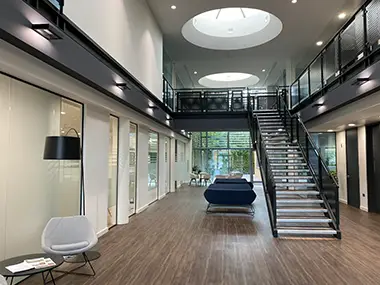Part L SAP Calculations
SAP Calculations perform a key role in the design and construction of new residential properties Discuss your projectPart L SAP Calculations |
Part L SAP Calculations
SAP Calculations perform a key role in the design and construction of new residential properties and show the local authorities building inspector that the property has been designed to meet minimum energy efficiency standards.
As a requirement of the Building Regulations Part L since 1995, most architects, builders and developers are familiar with the regulations. However, for many people building their first home it will be a new and often challenging aspect of the planning and building control process.

What do SAP Calculations do?
- Demonstrate compliance with Part L of the Building Regulations, which relates to energy efficiency.
- Reduce Carbon Emissions associated with heating a dwelling.
- Reduce Running Costs for Homeowners and Tenants.
- Produce an Energy Performance Certificate (EPC), which is required to sell or let a property.
SAP Calculations should ideally be started at the design stage of any development and often before planning has even been submitted for approval. SAP Calculations may also be needed for a conversion or extension, but slightly different rules apply.
As MEP Building Services Engineers, we can also design an energy efficient heating system along with any lighting, ventilation and renewable systems needed in partnership with the architects designing the bricks and mortar.
What are SAP Calculations?

The ‘Standard Assessment Procedure’ or SAP is the only official, government approved system for assessing the energy rating for a new home.
The SAP Rating is measured on a range between 1 and 100+. The higher the SAP rating, the lower the fuel costs and the lower the associated emissions of carbon dioxide. A rating higher than 100 means you are exporting energy and are helping to reduce carbon emissions in the UK.
SAP Calculations look at the construction of the home and how well insulated it is along with the heating system, internal lighting and any renewable technologies installed. It does not include energy used for domestic appliances.
Why do I care about SAP Calculations?
Compliance. In order for properties to be built, the builders will need to gain a ‘pass’ on their SAP Calculations. If the property does not pass, Building Control will not sign off the development and the property cannot be let or marketed for sale. Additionally, the property may not be able to get a mortgage against it.
It is important to employ a SAP assessor at the beginning of a new project, so that they can give the architect and building confidence in what they are building will pass compliance before a single brick is laid.

The effect of different construction types, heating systems and technologies can impact the ratings greatly so being able to confirm the rating at the start of the project based on the design saves many unnecessary alteration costs down the line.
As the SAP Rating indicates the energy performance of the property, which in turn creates the Energy Performance Certificate (EPC) which all buyers and tenants see in the marketing documents. The better the rating the more attractive the property is to potential buyers and tenants, which in turn affects the properties value.
Frequently Asked Questions About SAP Calculations
What is Involved with SAP Calculations?
The SAP Assessor will work from architecture plans and construction detail, together with a full HVAC (heating, ventilation and air conditioning) specification. For this reason drawings need to be scaled, accurate and show all elevations, sections, floor and site plans.
The assessor will scale off of these plans to create a computer model of the dwelling(s) in government approved SAP software.
The buildings construction and thermal insulation detail is added along with all the proposed the heating, lighting, ventilation and renewables being installed.
Once complete the software runs an annual simulation of the building heating and lighting needs to assess the overall energy usage of the property which calculates the energy efficiency of the property. The SAP calculations produce a report detail a number of results, from heat losses, energy demands, CO2 emissions and renewables contributions, to name just a few.
How Do I Pass SAP Calculations?
In recent years there have been significant changes to the SAP metrics and Part L Building Regulations. Starting a new development without a design stage SAP assessment is not an option and can end up costing a developer significant amount of money.
The UKs Climate Policies and Regulations around CO2 emissions targets have tightened enormously in recent years. A build designed and constructed 5 years ago would likely not pass todays regulations.
There are a number of factors that go into why some builds fail and some pass, from the ratio of external walls to internal floor area, the type of a boiler installed, the thickness of wall insulation, to which direction the house is pointing in relation to the sun.
The fuel being used to heat the home can be a significant factor. The SAP calculation compare the carbon emission against a property using natural gas. Som properties may not have a mains gas connection so may be looking to use Heating Oil or LPG as a fuel source. These fuels have higher cost and CO2 emissions factors compare to Natural Gas so making it harder to pass compliance without increasing insulation levels or adding renewables.
What can I do to improve my SAP Calculation Rating?
Come speak to us before starting a project. We have worked with self builders to development of multi storey apartment blocks, we pride ourselves on helping our clients. However here are a few tips:
- The Minimum U-Values are there to be beaten, not followed
The U-Value is a measure of how well insulated a building element is, the lower the value the less heat can pass through it.
If the building is very well insulated, less heating is then needed to maintain the internal temperature reducing the associated carbon emissions and running costs. This may also remove any need for renewable technologies to get a ‘pass’. It is always wise to install try and over insulate the walls, floors and roofs were possible. The cost of adding an additional 50-100mm of insulation can be negligible in the overall construction costs of building a wall.
- Keep the cold air out!
Air infiltration can account for over 50% of heating costs in standard buildings. All new buildings are required to have an Air Tightness Test upon completion and the resulting figure is entered into the SAP Calculations. Make sure the envelope is sealed tight and get a pre-test check carried out before the internal decorations start encase improvements are needed, as there are minimum requirements that have to be met.
Current air tightness requirements mean building are so well sealed that ventilation systems with heat recovery will likely be need to remove stale air from the property. The heat recovery aspect reduces the amount of heat being extracted from the property as it transfers it to the replacement fresh air being brought in.
- Windows and doors lose a lot of heat
Windows are doors allow lots of natural light into the property but are the worst thermally performing element in a property (10-15 times worse than walls). Try to get to the U-Values on these element as low as possible when specifying these items, ideally 1.4 W/m2K or less and consider triple glazing as an option, which will also help with noise.
- Pay attention to thermal bridging
Where there is a change in construction, for instance around windows, doors, or where the roof meets the wall, additional structural support may need to be installed at that junction. This junction may add a break to the normal insulation of the building and may need to be insulated in a special way. Follow a scheme such as Accredited Construction Details (ACD’s) which will allow us to avoid using default figures.
- Heating Controls
There is nothing more energy efficient than being turned off. Zonal heating and load / weather compensators for boilers reduce the amount of wasted energy being used. They may often have a more significant effect on the SAP rating than the efficiency of the system itself.
- Start Early!
The most important thing is to start early, before the construction begins and often before planning has even been submitted for approval. If we start doing the calculations half way through a build, it may be too late to make the cost effect changes needed to pass the SAP calculations
Starting the SAP calculations to late leads to many bad practices and expensive mistakes. More costly alterations or additional renewables may be required to ‘pass’ or even worse the demolishing what has already being built because the insulation levels are incorrect.
Are SAP Calculations Just for New Builds?
Not at all. Under Part L of the Building Regulations many extensions, conversions and change of use projects will require SAP Calculations such as:
- Extensions with more than 25% glazing-to-floor area (SAP Calculations for Extensions)
- Converting Commercial Properties to Domestic use.
- Converting a single property into multiple flats or apartments.
- Barn conversions.
If you are unsure if you need SAP calculations carried out the contact us to find out.

